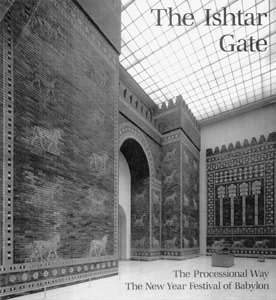
Page 6
The Ishtar Gate of Babylon
I recently had the opportunity to visit the Pergamon Museum
in Berlin. It houses the restored Ishtar Gate of Babylon. The attached gives
a full view of the gate, and of a mural that decorated the throne room. It
is really a very impressive structure.
Also restored was a cuneiform tablet that states that the builder
of the gate was none other than our erstwhile 'friend' Nebuchadnezzar. This
would date the gate to the time of the exile, and may have impressed our ancestors.
One item I found interesting, was a listing of the months in
the Babylonian calendar. It reveals how closely Jewish and Babylonian cultures
are related:
BABYLONIAN ; HEBREW
The only variation is the month of Heshwan. Tammuz, the Babylonian
god, is the same as Dumuzi, the Sumerian deity. Apparently the Jews retained
a soft spot for Tammuz. The prophet Ezekiel (6th century BCE), complained
in Ez. 8:14 that some Jews were observing the fast of Tammuz in the Jerusalem
Temple. Later in the same chapter, he also refers to some who were worshipping
the sun, a hangover from the days of exile in Egypt.
Naim S. Mahlab
Montreal
 Scribe:
An exact reproduction of the Ishtar Gate, perhaps modelled on the German version
was carried out in Baghdad 50 years ago, as the entrance to the new Iraqi
Museum. It was never completed and it was rumoured that the architect managed
to build for himself a luxurious villa out of the funds.
Scribe:
An exact reproduction of the Ishtar Gate, perhaps modelled on the German version
was carried out in Baghdad 50 years ago, as the entrance to the new Iraqi
Museum. It was never completed and it was rumoured that the architect managed
to build for himself a luxurious villa out of the funds.
In the 80's Saddam Hussein spent large
sums to restore the ruins of ancient Babylon and make it an important tourist
attraction.
Naim Dangoor writes: Historians state
that the first part of the exile to Babylon by Nebuchadnezzer in 597 BCE of
some 11,000 captives, the cream of Jewish society, including artisans, architects,
engineers, town planners, craftsmen, and other professionals was for the purpose
of re-building and improving his capital. Nebuchadnezzar wanted Babylon to
surpass Nineveh the Assyrian capital, which his father had captured only 28
years earlier, and so he brought all the Jewish craftsmen and artisans who
eventually made Babylon the most elegant city of its day. (see The Exilic
Age by C.F. Withey. Longmans. 71pp.)It is most likely therefore that the
Ishtar Gate and other famous Babylonian landmarks were the results of their
endeavours.
Historical note: Babylonia
(From Gulf to north of Baghdad). Non-Semitic race. Sumerians, with non-Semitic
language ruled. About 3000 BCE Semitic tribes forced their way from region
of Arabian desert and took most of northern part of the country which became
known as Akkad. Both people lived side by side but between 2300-2000 BCE Sumer
had supremacy. After 2000 BCE power passed to Semitic population. Meanwhile
other Semitics (Amorites) arrived and made Babylon their capital and took
over the old culture (old Babylonian) was created. This lasted until c.1760
when kingdom was destroyed by Hittites and, later, Kassites. The latter's
rule lasted until c.1200. Meanwhile, in the north, Assyria had risen to power
and more than once overran Babylonia. From c.900 Babylonia often came under
yoke of Assyria especially as a result of quarrels between old Babylonian
and new Chaldean tribes which penetrated into South Babylonia.
Often Chaldean as well as Babylonian
kings on throne were often appointed by Assyria. In the year 625 better times
came from Babylonia with the accession of Nabopolassar (Chaldean). With the
help of the Medes he destroyed the Assyrian kingdom for good which was divided
between the Medes and Chaldeans. Under his son Nebuchanezzar this 'New Babylonian
Empire' reached its peak (he conquered Judah). But under his son Ewil Merodach
(562-560) who pardoned Jehoiakin and his successor, a rapid decline came.
A new Indo-Germanic Persian kingdom rose and in 539 under Cyrus (ruled 558-529)
Babylonia became part of the great Persian Empire (for over 1000 years).
The Jewish exiles in Babylon had
a hand in this. When Nebuchanezzar went back in 586 BCE to destroy the Temple,
and bring most of the Jews captive to Babylon, they waited for an opportunity
to take revenge. This came with the rise of Cyrus and by a swift plan of diverting
the river from Babylon, the capital had to surrender unconditionally within
48 hours without a 'shot' being fired.
A thousand years later when the Persians
in their turn began to persecute the Jews, Babylonian Jewry invited the Moslem
Arabs and helped them take over the land of the rivers.
Although Babylonia, or Iraq, was largely
populated by Jews, the population was still a mixed one and in the course
of time the non-Jewish population became majority.
Originally the princes of exile were
collectors of taxes, later Parthians elevated them to real princes in recognition
of services.
Caliph Omar awarded the Exilarch Bostanai
for a wife the daughter of the conquered Sassanid Chosroes II. Jews of Babylonia
sided with Ali against Muawiya. A Jewish preacher Abdullah ben Saba laid the
foundations for the later sect of Shiites.
Ali made Kufa his capital and thither
Jews came (in 641) who had been expelled from Arabia. Thus perhaps Arabic
gained ground among Iraqi Jews.
The lesson to learn from all this
is that the Fertile Crescent is the greater homeland of the Jewish people,
and that to secure its survival, Israel must take an interest and take part
in the management of all this region.
Home
If you would like to make any comments or contribute to the
scribe please contact us.